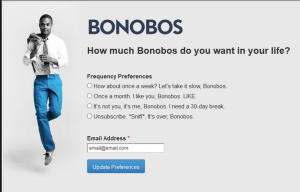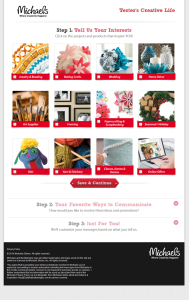The other day my manager asked “What is the value of a preference center to us as a business?”
I thought to myself (only), “Does he really want to rationalize why he shouldn’t send the same message to his entire database, or a segment of it, whenever he wanted?” It got my wheels turning to validate having a preference center.
 The benefit to consumers is obvious: control, the option to outline what messages they want to receive, and how often they want to hear from us. A preference center empowers your customer by giving them control to only receive the right messages about content/brands that they are interested in at their preferred times.
The benefit to consumers is obvious: control, the option to outline what messages they want to receive, and how often they want to hear from us. A preference center empowers your customer by giving them control to only receive the right messages about content/brands that they are interested in at their preferred times.
However, what are the benefits to brands and marketers of having a preference center?
- It helps you as a marketer to understand your subscriber’s interests and/or needs. This is precious data that many companies spend top dollar with third parties to determine. Build it and they will come – build your own preference center and allow your customers to share and continually update their information for you. A good example of this is PaperStyle, which captures customer interest starting with an email.
- The user data produced by your preference center will allow you to better target your marketing spend by focusing your resources on the interests/brands outlined by your customers, which has the long term value of reducing and streamlining your overall marketing expenses.
- Having a preference center allows you to have a customized and personalized one-on-one customer relationship and accelerate the path to purchase. Personalization is a basic expectation of many empowered customers. Target your marketing efforts where your customers are interested, and build that one-on-one relationship with them and make them feel valued. Continue that personalized conversation to help nurture their brand loyalty, which will eventually result in keeping them continually informed and in the sales cycle.

- Use your preference center to control opt-out/down. If you do the cost-benefit analysis of the average value of individual customers to your business, you’ll probably quickly see that it is more cost-effective to retain customers by allowing them to determine how often they want to hear from you, rather than letting them opt out entirely and then spending the time and marketing resources to replace them. For example, it’s better they chose to hear from the particular hotel or hotels that they are interested in, rather than opt out from hearing from your entire company about any of your hotels because they had no other choice. That could be the difference between losing a $5 or $10 entirely, if you had 2 brands a value to you of each customer is $5 per brand. If they did not have a choice and opted out entirely you just lost $10, rather than on $5 if they still chose to hear from one brand.
- Integrating your preference center with marketing automation will allow you to build scoring models based on customers’ profiles and site activity, and automate relevant emails based on consumer preferences or site behavior.
- And finally, the Results:
- 47% of U.S. email and online marketers reported that increasing email relevance resulted in improved deliverability (Lyris Annual Email Optimizer Report)
- Frequency is one of the top reasons that people opt out; 64% of consumers opt out due to receiving email too frequently (Marketing Sherpa)

- 66% of US online consumers, ages 15 and up, made a purchase as a result of email marketing messages.*
- Nurtured leads produce, on average, a 20% increase in sales opportunities vs. non-nurtured leads *Demand Gen Report
Here are some great examples of preference centers that we reviewed that we think get it right:
- SCJohnson
- Michaels
- Kraft
- Betty Crocker
One of our favorite opt down experiences is with Groupon.

 (
(